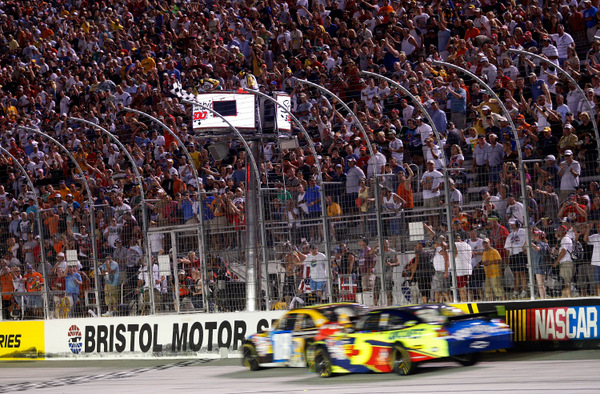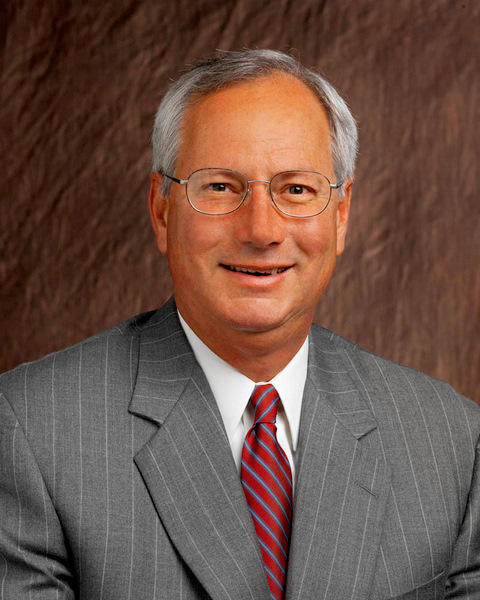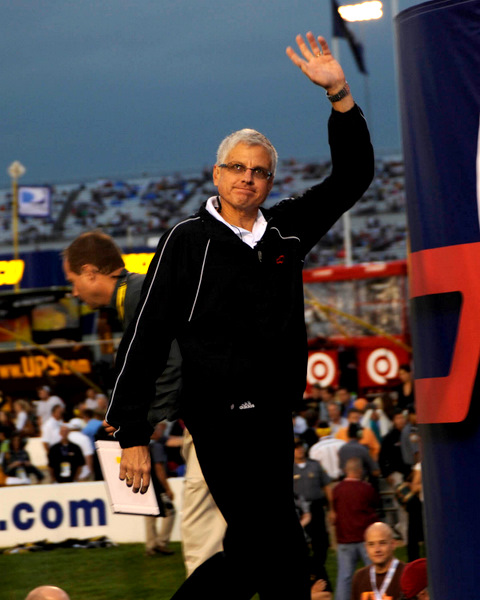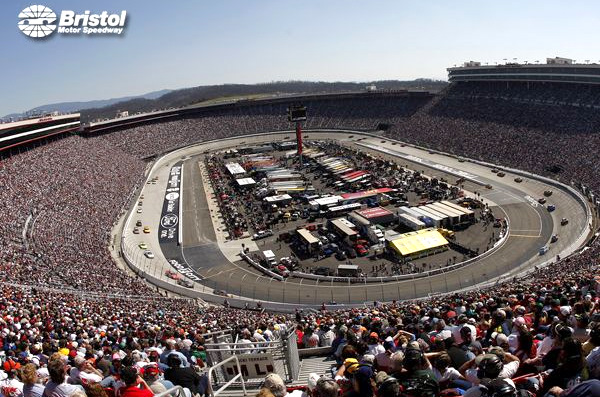Bristol, and the NASCAR haulers are rolling in....but filling 160,000 seats, now that's going to take a good marketing campaign

Bristol Blur: Kyle Busch nips Mark Martin, and 160,000 are watching (Photo: Getty Images for NASCAR)
By Mike Mulhern
mikemulhern.net
BRISTOL, Tenn.
Filling these 160,000 seats for Sunday's 500, wow, now that's a job.
And Jeff Byrd's record of consecutive sellouts at Bristol Motor Speedway – hey, he's the only guy who has a record of consecutive NASCAR tour sellouts – is on the line again this weekend.
Fortunately economic blue skies continue to brighten this week across the US, with more good news for NASCAR team owners, with Wall Street hitting new highs across the board, and so many company stocks are hitting fresh highs that it's almost a deluge.
And now Byrd and Clay Campbell, the two veteran stock car racing promoters who are in the spotlight this week and next, as the NASCAR Sprint Cup tour plays roughhouse at the sport's two half-miles – this, a high-banked monster; next week's Martinsville, a flat-track terror – are hoping that some of that economic uplift helps boost their own businesses.
Ticket sales here in the heart of stock car country could be a bellwether for the rest of the spring, and stops at Phoenix, Texas and Talladega.
While Byrd, Bristol's track president, is sidelined at the moment with medical issues, Campbell is helping carry the freight.
Clay Campbell, Martinsville Speedway boss, says NASCAR's promoters have to be game-on to win in this economic climate. Fortunately it looks like the economic tides are beginning to turn. (Psss: Did Clay really shave that mustache for this weekend's race?) (Photo: Martinsville Speedway)
How to market NASCAR tickets in this rocking-and-rolling economy? Campbell, Martinsville Speedway boss, says it's taking a full court press.
"We're still sticking with tradition routes, like print media and electronics media," Campbell says. "But now we're also going into the 'new age.'
"You have to be innovative; you've got to get creative. You can't keep doing things the way you did 15 or 20 years ago.
"So we're pushing the envelope....though not to anything that's so far out.
"We're all faced with challenging times so you have to look at something different.
"Still I say that the traditional ways of marketing have always worked, and we haven't abandoned that. We're just adding to it."
And so are Carl Edwards and Brad Keselowski, whose Atlanta run-in has become a hot topic in stock country, and good fodder for NASCAR marketers – Texas' Eddie Gossage is using that controversial crash footage as part of his own promotional campaign for next month's Texas 500.
Of course there is more to NASCAR marketing than just ticket sales and TV audiences. This sport has some 600 corporate sponsors, each with a message and a target audience.
Detroit is a big one, naturally. And Detroit is still trying to get back on track; in 2007 the manufacturers were pushing nearly 17 million cars out the door...where this year the goal is only 11 million.
"So we've had to look differently at motorsports," says Terry Dolan, marketing boss for Chevrolet's racing division.
"As you look at how people consume media, it has evolved significantly.
"My kids, who are in their 20s, when they watch much TV, they don't just watch TV, they watch it with their laptops on. They are multi-tasking, on Facebook and other social media.
"So as we (at GM) have observed behavior shifts, we have reallocated resources from what has been traditional print media and quite frankly broadcast too – and we are buying more space in the digital landscape.
"The beauty of that is, if you do it right, you are able to see the behavioral side of that as it happens.
"If I run a TV commercial during a race, you have an idea of how large the audience might be, based on the TV ratings. But that kind of stops there.
"If we buy media on-line, we can literally do a 'tile,' and we can track that and see what happens. And as we get more and more sophisticated, as we put up a website, we can watch people and see what room they 'walk into' on the website, and measure how long they spend there, and where they go to exit. So you can watch in-flow, behavior, and out-flow.
"And that makes you more educated.
"So the more we can use the digital tools to guide us, we can optimize our spend, because we can do more of what is working and less of what is not."

Ex-RJR marketing whiz, now Bristol boss, Jeff Byrd: Armani suit, Gucci shoes, Christian Dior tie.....hey, how about something Versace to round it out? Got to stay one-up on bossman Bruton Smith (Photo: Bristol Motor Speedway)
One current example is the Jimmie Johnson GM truck pitch on the web, which involved several layers of interaction by the viewer, almost unrecognized by the viewer himself.
"When we purchase on-line media, we can meter each one of those lines and see how impressions we purchased, how many actually took the behavioral movement to go to winjimmiejohnsonsilverado.com, and we can watch the interaction they have with the site – which videos did they watch, which video is the most popular?
"Do they simply enter and leave?
"Do they explore our partner sites, and how long do they spend on our partners' sites?
"That makes us much savvier marketers."
So just who are NASCAR fans today?
That's an interesting issue, and rather complex.
First, TV ratings -- which many have pointed to as part of a 'sky is falling' scenario in this sport – have become a hot button issue that perhaps should be put in better perspective, because Fox' target audience and ESPN-ABC's target audience isn't the same target audience that Byrd and Campbell and many NASCAR sponsor companies are looking at.
This sport's demographics may need sharper, clearer focus. For example, the vast majority of NASCAR fans are 35-and-over, while TV sports marketers, for whatever reason, are – perhaps myopically – focuses on 18-34 males. In fact, the average NASCAR fan may be around 43-years-old, and some report that is an older demographic than the sport reached just a few years ago....though why is unclear.
Campbell agrees that this sport targets a number of differing demographics.
"For us, from the track standpoint, a lot of fans who watch on TV may be TV-only fans," Campbell says. "We need people in the seats as well as people watching at home.
"And the people we're trying to reach (with track marketing) are obviously the people we want at our events.
"We still have an older fan base....and in our marketing efforts, we're trying to target newer fans. We have to cultivate some new fans. So we're doing things with colleges, and school systems, trying to go after the youth market. That's critical to us.
"We've got to get to new fans. And we've got to do things that catch their attention and keep it.
"A lot of focus is on youth now."
Competition between tracks? Campbell says no: "If they can attract someone, to become a NASCAR fan, then it's good for us too. And vice versa.
"While they're looking out for their interests and I'm looking out for mine, if we can bring along some new people who enjoy our sport and like it, it will help us all."
Much has been made about the problems making inroads in the Southern California market (whether it's NASCAR or the NFL), each track adds its bit to the bigger picture. For Martinsville, the target fans, after Virginia and North Carolina, are in Pennsylvania, "which is a priority for us, since it's our third largest draw," Campbell says. "That and the Northeast are good markets for us."
How to reach fans and make the pitch, how to reach potential fans and fan their interest, how to find those potential fans in the first place....it's all part of the puzzle, for Byrd, for Campbell, for Dolan:

GM marketing man Terry Dolan (Photo: Dorsey Patrick/Chevy Racing)
How does 'social media' fit in?
This is Dolan's take: "Four years ago we started to create what we called 'Chevy Nation,' and take the power of the brand and the lifestyle connectivity, whether it's through baseball or racing, or what other sports or marketing properties we're involved with, and create a social community.
"The idea was sound...but the (digital) infrastructure wasn't there yet. So we found ourselves with a great 'landing page,' but we weren't getting the traffic we needed. So we stepped back, scratched our head, and asked 'What are we doing wrong?'
"What we have found that Facebook has become a powerful tool.
"In fact when Jimmie won his fourth championship (late November), that Sunday night we had a switch ready to go on our Facebook ad, and we turned it on...so fans could go in and leave Chad (Knaus) and Jimmie and the team a congratulatory message.
"In just three weeks we had thousands upon thousands of consumers hand-typing in thanks.
"And now as fans come there, it becomes a social interaction. If you log on during the race, you'll see fans – like my kids do – who log on, while watching the race, and interacting with other fans, who might be in Sacramento or Chicago."
It takes a real racer to understand racing. So Martinsville's Clay Campbell is taking the wheel in his own hands (Photo: Martinsville Speedway)
However, there is a big piece of this puzzle missing – because NASCAR's common templates have erased most of the brand identity from what is out on the track with what is out on the street. That brand identity issue is a big part of the controversy over Chevrolet's refusal to 'badge' a NASCAR Camaro.
Remember when the Detroit angle in this sport was so visceral? When Richard Petty jumping from Chrysler to Ford was so controversial, when Junior Johnson's jump from Chevrolet to Ford created such angst.....
Is that emotion still there? Is it a marketing mistake not to push that angle – Mustang versus Camaro, perhaps, which certainly has a spicier ring to it than Fusion versus Impala.....
Maybe NASCAR, or Bruton Smith, with his Speedway Motorsports operation, or the France family, with its International Speedway Corporation, could take it the next step and revive the IROC – the concept of a dozen drivers racing four sprints each season in identically prepared race cars – with Ford men in Mustangs, Chevy men in Camaros, Dodge men in Chargers. The GrandAm series and American LeMans series has Detroit cars that could easily be used....
And maybe Detroit could take that all a step further and use special production engines too.....anything to create a stronger link between NASCAR racing and Detroit, between the track and the street. For example, GM's Corvette street engine makes 436 horsepower – certainly more than enough to run 200 mph at Daytona and Talladega. And Ford has a new Mustang V-8 coming....
Are NASCAR and Detroit using all the tools they have? Or are they leaving too much on the table.
Dolan agrees that the moves toward improving safety following the death of Dale Earnhardt in 2001 "over time, we focused on safety so much, and race parity, that we lost some sight of the relevancy of the identity of the car.
"So now as we look at the Next Gen car (car-of-tomorrow II), it's how can we build in more of the identity of the car.
"The fans are clear – they root for their manufacturer, they root for Chevy, they root for Ford, for Dodge....And that connectivity is clearly a powerful asset. And NASCAR wants to keep it, and to maintain the emotion behind the brands in the sport.
"The new Nationwide car (which won't debut until July) is a better execution of that. And in the Next Gen I think you'll see more and more manufacturer identity coming through."
For example, Dolan says "We'll have fuel injection on-track in 2011. Tests have been on-going behind the scenes.
"The next step is to build a 'sustainability' program – using bio-fuels."
But the bottom line, Dolan says, is a marketing program that produces "efficient, effective, quantifiable results.
"That's good – because we're all doing things now we probably should have been doing more aggressively previously.
"And we're now able to show results, which we couldn't have done four or five years ago.
"All this partnership marketing has been working. When you look at 'Jimmie's Silverado' campaign, we're working with Sprint, with Lowe's, with the Hendrick organization.....and synergistically the energy gets spread across, so you don't have to spend as many vertical dollars to get the bang for your buck that each of us would have had to do individually."
[Note: You can use Twitter as an easy headline service for mikemulhern.net stories, with our instant Tweets to your mobile as soon as our newest NASCAR story is filed. And mikemulhern.net is mobile-friendly for viewing. You can also use the orange RSS feed button as a quickie headline service on your laptop or home computer for mikemulhern.net stories, by creating a Live Bookmark RSS feed on your web browser's toolbar. Or you can create a Google Alert for mikemulhernnet.]

One of the seven wonders of the NASCAR world: Bristol (Photo: Bristol Motor Speedway)
© 2010-2011 www.mikemulhern.net All rights reserved.
Web site by www.webdesigncarolinas.com







NASCAR Demographics
Could it be that the reason NASCAR fans are getting older is that the percentage of older Americans is increasing, and that the older fans are the ones who have the money?
Marketing wizards still don't get it. The 18-34 segment is fickle, broke, and preoccupied with its digital toys.
Reply to comment